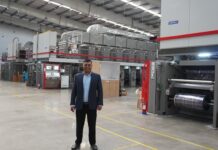Among flexible packaging converters, although there are numerous complaints about margins being thin, investment continues slowly but steadily. The overall consumer product, food, and FMCG segments are flat and the packaging economy is extremely competitive.
Much of the work is shifting to smaller converters and few of the bigger converters can invest in substantial projects, although there is a trend among them to buy smaller players to reduce costs. In the accompanying graph, we can see that the combined turnover of the fourteen flexible packaging companies for which we have the data, have been steadily growing in the past ten years. However, their combined turnover fell by 3% between FY 2022-23 and FY 2023-24.

While not much greenfield capacity is being added, as a matter of course one or two new plants are under construction. The trend among those converters who are investing is to add faster and more automated gravure and CI flexo presses. In the current financial year, we expect about half-a-dozen imported gravure presses in the 400-meters-a-minute and above category to be installed together with three or four from leading Indian manufacturers.
Gravure and flexo presses
Nevertheless, these are good times for smaller flexible packaging converters who continue to lower prices and win work from the bigger packaging companies. Altogether, the flexible packaging companies will install about 100 gravure presses till March 2025 – of which 10 will be above 400 meters a minute; another 40 that are likely to be above 300 meters a minute; and, finally the balance 50 will be in the range of 200 to 250 meters a minute. To some extent, these press installations are merely natural replacements for older presses that can no longer compete in quality and productivity.
 As far as CI flexo presses, there are likely to be 10 to 12 installations till March 2025. These will come from Bobst, Uteco, W&H, Comexi, Soma, and the Indian manufacturer Echar. For CI flexo there seems to be a global slowdown. Experts we have spoken to do not expect a revival for at least another two years.
As far as CI flexo presses, there are likely to be 10 to 12 installations till March 2025. These will come from Bobst, Uteco, W&H, Comexi, Soma, and the Indian manufacturer Echar. For CI flexo there seems to be a global slowdown. Experts we have spoken to do not expect a revival for at least another two years.
For many converters, top-line growth at any cost seems to be aimed at scaling up operations in the search for investment and joint venture partners. Apart from the consolidation of smaller players, the bigger companies are looking for private equity and, in some cases, thinking about taking their companies public to raise money from the stock market.
Slitter rewinders
As far as slitter rewinders, the leading Indian suppliers will probably install 100 machines in the financial year. It seems that the industry is not particularly growing very fast, but the work is changing to shorter runs of each pack, and frequently more designs due to regionalization or other customization. This means that slitter rewinder changeovers are going from 4 to 5 in a shift, to as many as 10 to 15. Digital presses for flexible packaging are also being acquired by mainstream flexible packaging converters. Thus in this important part of the converting operations, the trend seems to be to add machines for faster and automated changeovers – as shown by companies like SP Ultraflex at drupa.











